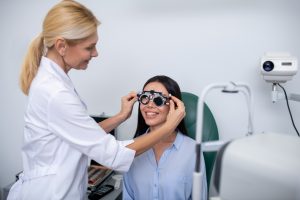If your vision is no longer correctable to 20/40 and you’re having trouble doing your everyday activities, you should go to a low vision clinic. These clinics’ doctors are specially trained to aid people who have vision problems that other eyecare specialists, such as retinal doctors or glaucoma specialists, can’t help with. Retinal doctors are medical professionals that specialize in treating retinal diseases that may be the cause of impaired eyesight. The vast majority of persons who require low vision therapies have exhausted their options with retinal specialists. Healthy people with great eyesight do not end up with low vision. The majority of eyecare facilities can assist persons who are ordinarily sighted.
When should you schedule an appointment at a low vision clinic?
If your vision is preventing you from carrying out your everyday duties, you should consult a specialist at one of the low vision clinics. They will assist you in maximizing your usable eyesight so that your everyday activities remain manageable and pleasurable. The majority of patients who suffer from low vision or vision loss are elderly and have an eye condition such as macular degeneration or glaucoma. Low vision is also common in younger persons who have had traumatic brain injuries or strokes. Some hereditary disorders, such as Stargardt’s disease, can affect children as well as adults. The condition of low vision is not genetic in and of itself, but the disorders that might cause low vision are.
What low vision aids and devices are available?
There are a variety of devices that can help you with your activity. Large-print books, hand-held magnifiers, computer-assisted gadgets, and so on. Telescopic glasses allow you to keep driving while maintaining your independence and freedom.
Many of the handheld electronic magnifiers make reading and writing considerably more convenient. Many people will reduce glare and adjust the contrast, magnify the image, and read the material back to you. Some people can read fast food menus back to you by taking images of them.

Many low vision clinics have occupational therapists on staff who can assist you in organizing your home to make it safer for you. Keeping clutter to a minimum and organizing cooking utensils and other items that may cause confusion or provide a hazard to the visually impaired.
People go to these clinics for a variety of reasons, including the desire to continue driving, reading, writing, or seeing loved ones’ faces. In most jurisdictions, the usage of bioptic telescopic glasses allows most people to continue driving. Spotting with the top scope and regular gazing through the carrier lens are possible with these little telescopes. It’s nice to be able to see street signs in the distance with these.
Escoops are another type of low vision lens that a low vision expert may recommend. These lenses magnify images, reduce glare, and can even move the image from damaged to healthy portions of the macula.
What services are provided as part of low vision center?
Of course, one of the most crucial things that will be done in the clinic is the examination. It will be an outpatient visit that will last a couple of hours. These clinics’ low vision doctors and occupational therapists will assist you in determining your visual strengths and limitations. They’ll show you how to use strategies to make the most of the vision you still have.
Excentric gazing, for example, is a technique in which you learn to identify the sweet spot of your vision, which is likely not straight on but rather next to looking straight. They’ll help you figure out which eye is the stronger one and whether they should always be used together if they’re near in strength. In many circumstances, a person may have one eye that is far worse than the other, and combining the two only makes matters worse. In these situations, it may be important to obstruct the worse eye in order to avoid “muddying the water.” In most circumstances, the “vision” itself will not be improved, but the ability to use the existing eyesight would.
What is the difference between low vision, legally blind and simply poor vision?
Many people get the terms “legally blind” and “poor vision” mixed up. If you are legally blind, you almost certainly have low vision, although this isn’t always the case. If you can’t adjust your vision to 20/200 or better for your central vision and 20 degrees of peripheral vision, you’re legally blind. Low vision simply implies that your vision has deteriorated to the point where you are unable to carry out your daily activities without trouble.
That could simply mean that your acuity is 20/50 and you can’t legally drive without help, or that you’re having trouble writing checks and reading the newspaper. Due to a disease process, your contrast sensitivity may be reduced, making it difficult for you to discern the difference between spices when cooking or between cleaning materials in the kitchen.
The personnel of these clinics’ major purpose is to keep people doing the things that make them happy and productive, as well as to keep them safe in their daily environments. The majority of people have been informed that there is nothing extra that can be done for them, and they are unaware of the many wonderful devices that are accessible to them.
These experts are committed to ensuring that those who have lost their vision preserve the quality of life that they deserve. Optometrists or occupational therapists commonly run the two types of poor vision clinics. The optometrist will prescribe optical equipment and tools, while the occupational therapist will assist with home devices to keep you productive and safe. They’ll give you an amsler grid to use as a self-monitoring tool. This is a grid that you will check on a daily basis to spot changes in your vision so that you may contact your other eyecare physician right away to avoid the underlying disease from worsening. A directory of these clinics can be obtained at lowvisionaids.org.
About Author :

Dr. Shaun Larsen specializes in the areas of low vision services as well as enhancing vision with contact lenses and he enjoys bringing a smile to the faces of his patients when he can help them see well enough to read, write, and sometimes even drive again. After receiving his undergraduate degree from Utah State University, he went on to obtain his Doctor of Optometry degree from Southern College of Optometry in Memphis, Tennessee. He keeps up to date with the latest technology and specialty devices to help his patients regain their visual independence.
“There is nothing more gratifying than helping a patient who has been told ‘nothing more can be done’ to see again.” – Dr. Larsen


 Home
Home










